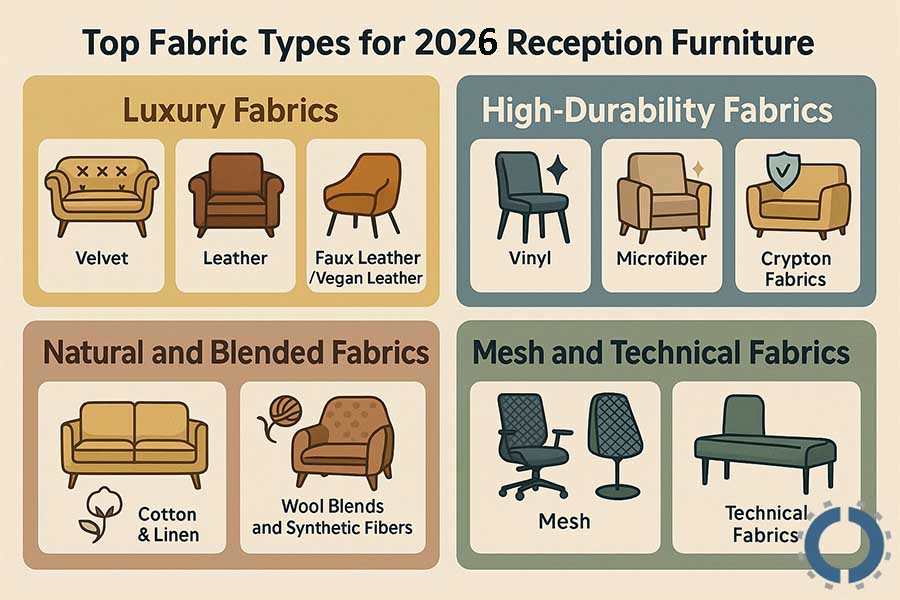Which Fabric Is Best for Reception Furniture? – 2026 Review

Reception area furniture is the customer’s first point of contact with your business.
Whether it’s an easy chair, a classic sofa, or a modern bench, these pieces of modern office furniture Houston create an initial image of your brand in the mind of the visitor and reflect your level of professionalism, appreciation for detail, and organizational identity.
What stands out most about this furniture is its fabric.
Now we want to know which fabric is best for reception furniture in 2026?
In 2026, the best fabric for reception furniture is performance polyester and vinyl-coated fabrics. They are durable, stain-resistant, easy to clean, and comfortable—ideal for high-traffic areas. Mesh is also a great option for breathability, particularly for reception chairs. Additionally, velvet and bouclé can add a touch of luxury and visual interest, especially when layered with other textures.
In this comprehensive and up-to-date article for 2026, you will be introduced to the types of fabrics on offer, we will examine the strengths and weaknesses of each, and we will help you make the best choice based on your space needs and work style.
Key Criteria for Selecting Reception Furniture Fabric
1. Durability
In high-traffic spaces like receptions, you should choose a fabric that is resistant to wear, tear, and constant use.
One of the common indicators for measuring the durability of fabrics in the furniture industry is the “Double Rub Rating”.
This test shows how many back-and-forth rubs the fabric can withstand before it wears out.
Fabrics with a rating above 100,000 double rubs are suitable for high-traffic environments (Commercial Grade).
Fabrics with a thread count of less than 30,000 are suitable for household use, but not high enough for reception!
So if your reception is high-traffic, be sure to choose a fabric with industrial durability.
2. Ease of Maintenance
Reception furniture may be exposed to stains, dust, dirt, and even germs daily.
Therefore, the fabric you choose should have the following characteristics:
- Stain Resistance: Fabrics protected with special coatings are more resistant to stains from drinks, food, or cosmetics.
- Easy Cleanability: Quick cleaning with a damp cloth or mild detergent without the need for specialized cleaning
- Antibacterial or antimicrobial properties: In medical or high-traffic spaces, this feature helps prevent the fabric surface from becoming a breeding ground for microbes.

You Might Also Enjoy: Top 10 Office Furniture Trends for 2026
3. Visual Appeal and Branding Alignment
The fabric of your reception furniture should align with your brand’s visual identity.
That’s why choosing the right color, texture, and fabric type isn’t just a matter of taste, but part of your branding strategy.
A law firm might require formal leather or velvet fabrics in dark colors, while a tech startup might prefer cheerful colors and modern textures.
You should also consider the psychology of colors.
For example, blue inspires a sense of trust, gray a sense of stability, green calmness, and red energy and courage.
Also, soft, uniform textures provide a sense of comfort, while textured fabrics add depth and richness to the space.
4. UV and Fade Resistance
If your reception furniture is exposed to natural sunlight, such as next to windows or in bright lobbies, you should choose a fabric that is UV-resistant and will not fade over time.
Cheap fabrics or bright colors usually fade or change color after a few months in direct sunlight.
Choosing reception furniture fabrics that are specifically designed for bright spaces will prevent premature discoloration.
5. Breathability and Comfort
In reception areas with high temperatures or without full ventilation, the fabric must be breathable to prevent sweating or discomfort.
Natural fabrics like linen or organic cotton are highly breathable.
Some mesh fabrics are also suitable for comfort in the heat.
In contrast, vinyl or synthetic leather fabrics, while easy to clean, may be uncomfortable to sit on for long periods of time, especially in the summer.
Top Fabric Types for 2026 Reception Furniture
Luxury Fabrics
One of the best fabrics for reception furniture is luxury fabrics.
Using luxurious fabrics such as velvet, natural leather, and synthetic leather (vegan) not only gives a professional and luxurious look to the reception space but also demonstrates your brand value, attention to detail, and distinctive taste.
However, each has its own characteristics and limitations.

You Might Also Enjoy: How to Measure an Office Space for Furniture?
1. Velvet
Velvet is a fabric with a dense texture and short pile that creates a soft, smooth, and shiny surface.
This special texture causes light to reflect on it in a unique way, which creates a luxurious effect.
Advantages
- Luxurious feel and soft texture: Velvet conveys a sense of warmth, elegance, and comfort.
- High visual impact: Reflects light in an attractive way that creates depth and brilliance of color.
- Ideal for formal and special spaces, such as hotels, law offices, or art companies.
Disadvantages
- Needs more care: Sensitive to stains, pressure, and scratches.
- May wear out more quickly in high-traffic environments unless Performance Velvet is used.
2. Leather
Genuine leather is made from the tanned skin of animals, usually cows.
This material is very durable, hard-wearing, and has a professional look.
Advantages
- High durability: One of the most durable options for high-traffic environments.
- Professional and classic appearance: Suitable for formal and management spaces
- Beauty over time: With use, its appearance becomes more attractive and personalized.
Disadvantages
- Sensitive to heat and direct light: May crack or discolor when exposed to excessive light.
- Expensive: More expensive than other options.
- Requires care and cleaning with leather-specific products.
3. Faux Leather/Vegan Leather
Faux leather is made from industrial materials (such as polyurethane or PVC) and is produced without the use of animal skin.
Vegan leather may be recycled or even made with bio-based materials.
This type of fabric is very inexpensive and is one of the best types of fabric for reception furniture.
Advantages
- More affordable than natural leather
- No animal skins are used
- Scratch and stain resistant, and in most cases, waterproof
- Easier to maintain and usually cleaned with a damp cloth
Disadvantages
- Faux leather typically doesn’t have the feel of real leather
- Unlike real leather, it doesn’t age over time, but it can peel or crack, especially if it’s of poor quality.
- It’s less breathable and can become sticky in the heat.

You Might Also Enjoy: Where to Donate Office Furniture in Houston [2026 Guide]
High-Durability Fabrics
In high-traffic spaces—such as reception areas, clinics, busy workplaces, or service centers—fabric durability becomes vitally important.
Performance fabrics are one of the best fabrics for reception furniture and are specifically designed to withstand repeated use, be easily laundered, and resist environmental elements.
1. Vinyl
Vinyl is a synthetic fabric made from polyvinyl chloride (PVC) that usually has a smooth, glossy, or semi-gloss surface and is completely impermeable to water.
This material is often used in spaces where hygiene and durability are paramount.
Advantages
- Very high resistance to abrasion, tearing, and scratching
- It is completely waterproof, and no moisture penetrates its texture
- Extremely easy to clean, just wipe with a damp cloth
- Resistant to stains and mild chemicals
Disadvantages
- It has poor breathability and may feel sticky in the heat.
- It lacks the natural, soft feel of textile fabrics.
2. Microfiber
Microfiber is a type of synthetic fabric made from very fine fibers and is very dense and soft.
Due to its dense texture, it is water- and stain-resistant, while also being more breathable than leather or vinyl.
Advantages
- It is very soft and feels comfortable and warm when sitting on it
- Resistant to stains, water absorption, and grease
- Affordable price compared to many other options
- Typically, anti-static (does not attract lint or hair)
Disadvantages
- May fade slightly over time in direct sunlight
- If stains are not removed immediately, they may penetrate the fabric
3. Crypton Fabrics
Crypton is an advanced performance fabric made from polyester, nylon, or a blend of them, and is made waterproof, stain-resistant, and antimicrobial during production through a special process.
Advantages
- Has internal antimicrobial coatings
- Very high resistance to stains, moisture, and odor
- Suitable for repeated washing without loss of quality
- It has a soft fabric appearance with industrial performance
Disadvantage
- Relatively higher price than regular fabrics
- Requires proper installation and standard care for full performance

You Might Also Enjoy: How to Arrange Office Furniture in 2026
Natural and Blended Fabrics
Fabrics made from natural fibers like cotton and linen have always been popular for their natural beauty, breathability, and comfort.
But for use in high-traffic spaces such as receptions, it is sometimes necessary to combine them with synthetic fibers to make them more durable and stable.
1. Cotton and Linen
Cotton fibers come from the cotton plant and are one of the most widely used natural fibers in the world.
Cotton fabric creates a special feeling of comfort due to its softness, finesse, and high breathability.
Linen is also derived from the flax plant and is one of the oldest textile fibers in the world.
Advantages
- High breathability: These fabrics allow air to pass through well, thus providing greater comfort in hot or summer environments.
- Natural and soft feel: Free from harmful chemicals, very suitable for environments with an emphasis on health or mental peace
- Minimal and calming appeal: Especially in Scandinavian, minimal, or biophilic designs
Disadvantage
- High wrinkle resistance: Linen, in particular, wrinkles very quickly, which can make furniture look untidy throughout the day
- Low abrasion resistance: Not suitable for high-traffic reception areas on its own, unless combined with other fibers
- Sensitive to greasy and colored stains: Some stains are more difficult to clean than natural fabrics
2. Wool Blends and Synthetic Fibers
Natural wool is often blended with synthetic fibers to increase its durability, reduce pilling, and make it easier to clean.
Synthetic fibers are also made in factories from petroleum derivatives and, depending on the type of manufacturing, can be very diverse, durable, and functional.
Because of durability, these can be one of the best fabrics for reception furniture.
Advantages
- Combining the natural beauty of wool with high durability
- Unlike pure wool, which can be rough or sensitive, these blends are more comfortable, durable, and sustainable
- Resistant to abrasion and discoloration, suitable for long-term use in office environments
Disadvantages
- Usually more expensive than all-synthetic fabrics
- May generate heat depending on the weave
Mesh and Technical Fabrics
Mesh and technical fabrics have become a popular choice for modern, minimalist, or startup-style reception furniture in 2026 due to their lightweight, modern design and unique functional features.

1. Mesh
Mesh is a type of net fabric with an open, porous structure that is made from synthetic yarns.
It is most commonly used in modern office chairs, especially the backrest and seat cushions.
Advantages
- Lightweight and breathable: Air flows easily through it, so it is very comfortable in hot reception areas or bright environments
- Minimal and modern look: It fits well with a startup or industrial decoration style
- Good resistance to abrasion and stretching
Disadvantages
- Usually used for reception chairs or back rests, not for the entire furniture
- May deform or tear easily when exposed to sharp or heavy objects
2. Technical Fabrics
Technical fabrics are engineered using advanced technologies to offer properties such as water resistance, antibacterial protection, UV resistance, stain resistance, and fire retardancy.
Advantages
- High performance in specific conditions, such as high traffic reception areas, humid, or exposed to direct sunlight
- Easy to maintain, resistant to industrial washing or disinfectants
- Variable appearance: from completely industrial to resembling natural-textured fabrics
Disadvantages
- Usually more expensive than traditional fabrics
- May not have the feel of a natural fabric
Conclusion
When it comes to reception furniture, you need to know that the fabric you choose represents your brand’s personality, values, and level of professionalism.
In this comprehensive 2026 guide titled “Which Fabric is Best for Reception Furniture?”, we tried to look beyond aesthetics to critical factors such as durability, comfort, maintainability, and brand consistency.
Each reception space has its own specific needs; for a tech company, modern, breathable fabrics like mesh might be appropriate, while for a clinic, technical, antibacterial fabrics like Crypton might be a priority.
So before making a decision, ask yourself: What feeling is this space supposed to convey?
Does the fabric you choose communicate this message to your clients?
A well-chosen fabric combines elegance, performance, and long-term value.

John Ofield is the owner of Collaborative Office Interiors. Houston’s trusted source for modern and commercial office furniture, office cubicles, demountable walls, office desks and tables, and complete workspace solutions. With more than 40 years of experience, he combines deep product knowledge with hands-on space-planning expertise to create ergonomic, productivity-focused work environments for businesses across Southeast Texas.


